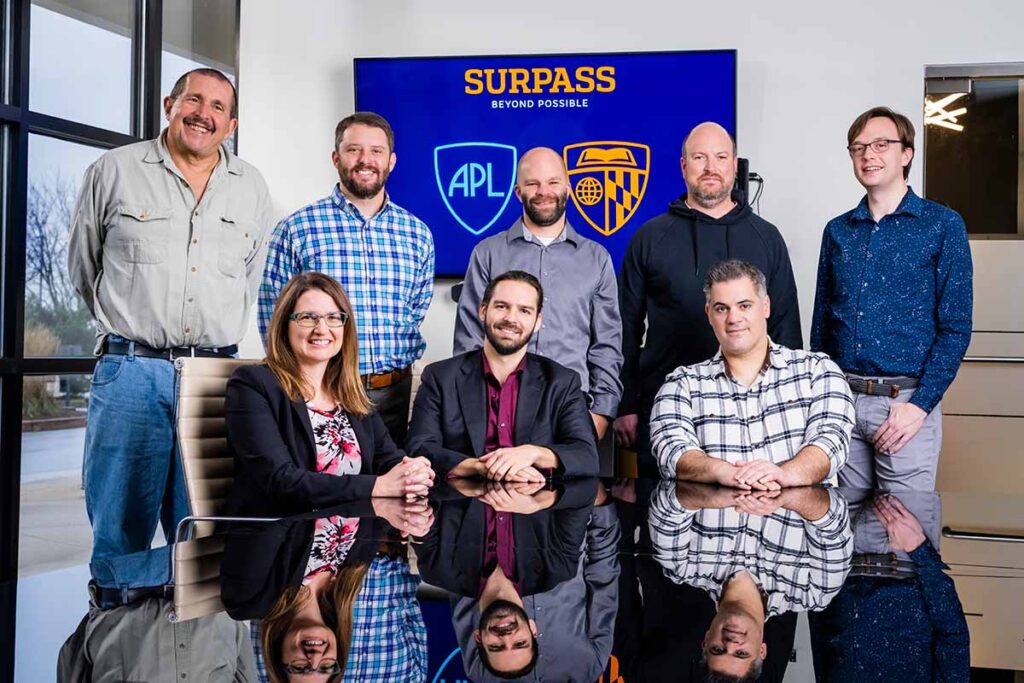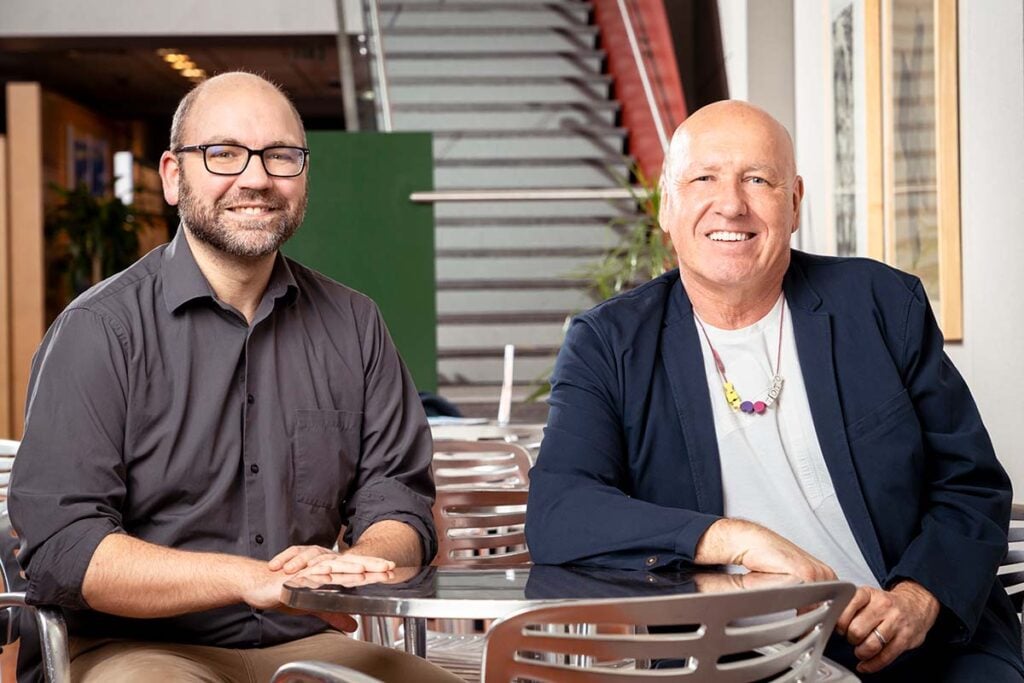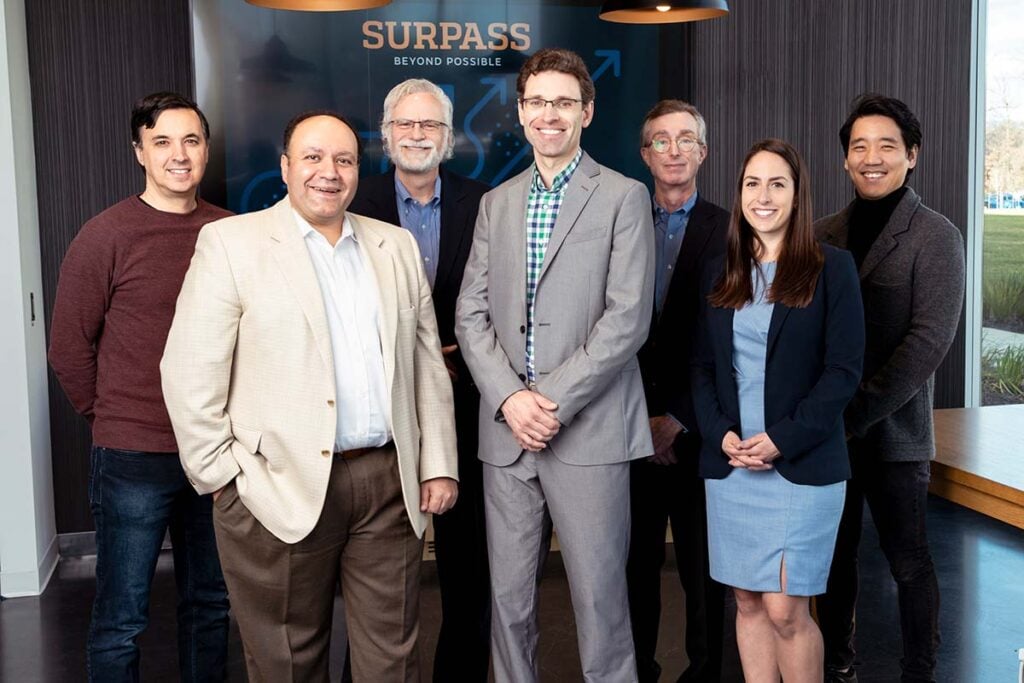First SURPASS Teams Tackle the Impossible, Targeting Blindness, Organoid Intelligence Among Societal Challenges
Written by Gabrielle Delisle-Ballard on April 26, 2023
Imagine being able to detect unhealthy brain activity just by putting on a hat, potentially detecting future incidences of dementia and Alzheimer’s years before onset, or making transportation in the upper stratosphere to and from space as common as domestic and international air travel. These are just two of the revolutionary innovations that teams from the Johns Hopkins University Whiting School of Engineering (WSE) and the Johns Hopkins Applied Physics Laboratory (APL) will tackle with the support from the SURPASS initiative’s first round of funding.
In 2022, WSE and APL created the initiative to enable groundbreaking solutions to ostensibly insurmountable challenges. The initiative is called SURPASS, and the mission is to “Go beyond possible” to tackle society’s seemingly impossible challenges.
“Researchers from both divisions of JHU really answered our call, collaborating to submit innovative proposals that have the potential for massive benefits to humanity,” said Ed Schlesinger, Benjamin T. Rome Dean, WSE. “This was a special initiative we created to see what we could do when talent from both divisions combined their skills and resources to tackle our greatest societal challenges. We are excited to see what the future holds with these projects.”
In its inaugural year, the program received 47 white papers. Researchers for the seven papers selected as finalists proceeded to the full proposal stage. SURPASS teams submitted research proposals addressing issues ranging from climate change to curing blindness and cancer to early disease detection, among others. Each proposal is led by two principal investigators (PIs), one from APL and the other from WSE. SURPASS leverages WSE and APL’s unique technical strengths and research and development communities, supporting cross-divisional teams dedicated to using innovative, multidisciplinary approaches to solving some of the world’s most pressing problems. The program also pulls in experts from across JHU, including the university’s School of Medicine (SOM) and the Bloomberg School of Public Health (BSPH).
Ultimately, four teams were funded:
BEAST: Between Earth and Space, the Next Strategic Flight Regime; CEREBRO: Enabling the Next Step of Human Evolution; Organoid Intelligence: Synthetic Biological AI; and Photoacoustic Retinal Prosthesis.
“The concepts that these collaborations will explore are combining cutting-edge research from different domains in new and inspired ways,” said Ralph Semmel, Director of the Applied Physics Lab. “This innovative partnership really draws on the creativity and curiosity of both APL and WSE, as we are excited to see what these investigations reveal.”
SURPASS program organizers say these proposals have the potential to lead to larger translational efforts with external funding upwards of $100 million. WSE is providing funding of approximately $3.75 million to be shared across the four selected projects over an 18-month period.
Between Earth and Space: The Next Strategic Flight Regime (BEAST)
Team: Co-PI Melissa Terlaje, PhD (APL); Co-PI Kevin Hemker, PhD (WSE); David Van Wie, PhD (APL); Michael Brupbacher, PhD (APL); Joseph Katz, PhD (WSE); Tamer Zaki, PhD (WSE); Morgan Trexler, PhD (APL)
The team behind BEAST envisions a future where sustained flight in the upper

Back Row, Left to Right: David Van Wie, Ph.D. (APL); Michael Brupbacher, Ph.D. (APL), Joseph Katz, Ph.D. (WSE), Tamer Zaki, Ph.D. (WSE). Front Row, Left to Right: Melissa Terlaje, Ph.D. (APL), Kevin Hemker, Ph.D. (WSE), Morgan Trexler, Ph.D. (APL). (Credit: Johns Hopkins APL/Craig Weiman)
stratosphere is not only possible but also commonplace. While only rockets and missiles are currently able to reach this altitude, air-breathing flight vehicles could be the answer to this level of transportation, enabling the shuttling of people and goods to and from space, providing new modes of surveillance, and paving the way for military missions and capabilities.
To achieve this lofty goal, a team of researchers and experts from WSE’s Department of Mechanical Engineering and APL’s Air and Missile Defense Sector (AMDS) and Research and Exploratory Development Department (REDD) theorizes that it will need to create radical advances to existing technology and capabilities to enable these types of flights, including enhancing the vehicle’s lift and control, creating high-impulse combustion, and applying advanced thermal management of the flight vehicle.
Such technology tweaks are necessary because the environment in which these vehicles would be operating in is tricky. The atmospheric pressure between Earth and space reduces lift and drag on these vehicles, and operating a scramjet engine in such high altitudes, where oxygen is diminished, becomes increasingly difficult. Given the speeds the vehicles would be traveling, combined with the altitude they’d reach, it would be necessary to modify the surfaces of the vehicles to ensure they could be maneuvered to their destination. In addition, it is necessary to maintain the vehicle’s temperature to ensure it can survive in the high-altitude environment, and also rid itself of the excess heat generated during high-speed flight.
With all of these challenges in mind, the team—including AMDS’s Melissa Terlaje and Dave Van Wie; REDD’s Michael Brupbacher and Morgan Trexler; and WSE’s Kevin Hemker, Tamer Zaki, and Joseph Katz —detailed a three-pronged approach focused on: (1) vehicle lift and maneuverability, which will require state-of-the-art modeling of hypersonic flow and turbulence; (2) enhanced thrust, via the development of activated microporous liquid fuels; and (3) thermal transport and morphing.
“BEAST is predicated on the premise that JHU should be a leader in the future of stratospheric flight,” said Hemker, project PI from WSE. “Combining APL’s predominance in hypersonic flight and related research areas with both organizations’ reputations for excellence in fundamental science in both fluid dynamics and advanced materials will enable demonstration of revolutionary approaches to thrust, lift and control, and thermal management, and lay groundwork to institutionalize WSE and APL as thought leaders and destination organizations for ultrahigh altitude, hypersonic, air breathing flight.”
CEREBRO: Enabling the Next Step of Human Evolution
Team: Co-PI Amy Foster, PhD (WSE); Co-PI Nicholas Pavlopoulos, PhD (APL); Jacob Khurgin, PhD (WSE); Mark Foster, PhD (WSE); Spencer Langevin (APL); Jeremiah Wathen, PhD (APL); Griffin Milsap, PhD (APL); Konstantinos Gerasopoulos, PhD (APL); Elisabeth Marsh, MD, PhD (SOM)
According to the World Health Organization, one in six people suffers from a

Back Row, Left to Right: Jacob Khurgin, Ph.D. (WSE); Mark Foster, Ph.D. (WSE); Spencer Langevin (APL); Jeremiah Wathen, Ph.D. (APL); Griffin Milsap, Ph.D. (APL). Front Row, Left to Right: Amy Foster, Ph.D. (WSE); Nicholas G. Pavlopoulos, Ph.D. (APL); Konstantinos Gerasopoulos, Ph.D. (APL). (Credit: Johns Hopkins APL/Craig Weiman)
neurological disorder. Despite this fact, there is still no way to routinely monitor brain health efficiently and cost-effectively with limited invasiveness.
“We can have blood samples taken to identify a litany of diagnosable diseases and deficiencies, even identifying many cancers in nascent stages, but brain science lags behind,” said APL’s Nicholas Pavlopoulos, one of CEREBRO’s PIs. “The average brain is a mystery—very few ask the question ‘How healthy is my brain?’ until a disorder arises.” CEREBRO seeks to change that.
Surveying the clinical landscape, the team learned that there is currently no wearable and portable device that is able to easily decode subtle cognitive information across the whole brain during natural everyday activities. Even the most current high-tech and least-invasive brain imaging technology is too cost-prohibitive to allow for mainstream usage.
One of the CEREBRO team’s goals is to make non-invasive brain scans readily available so that they may become as common as routine checkups. The team envisions a future where a data pool of brain-health metrics from millions of brains may help doctors and scientists unlock the mysteries of neurological disorders (such as Alzheimer’s disease) years before onset, and enable non-invasive applications from human performance monitoring to brain computer interfacing. The technology would be in the form of a wearable, portable device for neuroimaging not yet possible because of a “missing link in the technology chain”—a new sensor that can measure a brain’s continually broadcasting magnetic fields in an unprecedented, highly sensitive manner. The sensor works by translating brain signals to the optical domain where extremely small signals can be measured with high precision.
“Measuring such weak signals at room temperature with a cost-effective chip-scale approach would be game-changing,” said JHU PI Amy Foster.
Organoid Intelligence: Synthetic Biological AI
Team: Co-PI Erik C. Johnson, PhD (APL); Co-PI Thomas Hartung, PhD, MD (WSE and BSPH); Lomax Boyd, PhD (BSPH); Brian Caffo, PhD (BSPH); David Gracias, PhD (WSE); Erin Hahn, J.D. (APL); Tim Harris, PhD (WSE); Jeffrey Kahn, PhD (BSPH); Bart Paulhamus, D.Eng. (APL); Lena Smirnova, PhD (WSE/BSPH); Francesco Tenore, PhD (APL); Brock Wester, PhD (APL)
AI is quickly permeating society in many ways, from our shopping experiences

Left to Right: Erik Johnson, Ph.D. (APL); Thomas Hartung, Ph.D., M.D. (WSE). (Credit: Johns Hopkins APL/Craig Weiman)
to the information and news we receive on the internet. However, artificially replicating the function and efficiency of the human brain remains elusive. The essential question for this team is: Can you manufacture intelligence and maintain long-term learning in an artificial brain?
“Despite emerging machine learning models to process images, videos, and text with high performance, progress is requiring exponentially increasing resources without a clear path to human-like intelligence,” said PI Thomas Hartung of WSE and BSPH. “This SURPASS proposal is focused on unlocking the power of biological computing as a potential capability to leap-frog the current state of AI.”
To do so, the team wants to utilize organoid intelligence (OI). Grown in a petri dish under controllable conditions, an organoid is a tiny tissue culture derived from stem cells that can be trained and observed through microelectrode interfaces. By studying an organoid’s behavior, the team can learn about changes in biological neural networks, which provides insight into the synaptic learning that is critical to understanding biological intelligence.
Because this is an emerging field, the team anticipates addressing ethical challenges tied to human stem cell bioengineering. There are also technology gaps to consider. Breakthroughs in neural interface are needed to determine whether input and output signals can be properly delivered to and from an organoid. Current AI technologies that are needed to understand and model brain organoids are also lacking.
To address the significant ethical challenges of OI, the team plans to conduct an empirical ethics study of the field to fully understand the risks of the technology and what would be needed to gain public support, trust, and confidence in the science.
Hartung and his group in JHU’s Department of Environmental Health and Engineering have developed a 3D brain-organoid model derived from induced pluripotent stem cells. The model incorporates brain immune cells, known as microglia, which are necessary for neural development and learning. The team aims to grow these brain organoids in phases, increasing biological mass to the ultimate goal of 1 billion neural cells. APL’s PI, Erik Johnson, said he hopes to have working prototypes within 18 months, but acknowledged that longer-term applications of OI for biological sensing and computing may still be many years away.
“As a scientist and engineer, I think this represents one of the most interesting and promising paths toward biological computing and modeling, which can fundamentally alter our understanding of brain function — the stuff of science fiction,” Johnson said.
Photoacoustic Retinal Prosthesis
Team: Co-PI Emad Boctor, PhD (WSE); Co-PI Seth Billings, PhD (APL); Peter Gehlbach, MD, PhD (WSE); Jeeun Kang, PhD (WSE); James Spicer, PhD (WSE); Francesco Tenore, PhD (APL); Breanne Christie, PhD (APL); Nora Lane (APL); David Shrekenhamer, PhD (APL)
Advisory Board: Russell Taylor, PhD (WSE); Raymond Koehler, PhD (SOM); Martin Pomper, MD, PhD (SOM)
Millions worldwide experience some form of visual impairment or blindness.

Left to Right: Francesco Tenore, Ph.D. (APL); Emad Boctor, Ph.D. (WSE); Peter Gehlbach, M.D., Ph.D. (SOM); Seth Billings, Ph.D. (APL); James Spicer, Ph.D. (WSE); Breanne Christie, Ph.D. (APL); Jeeun Kang, Ph.D. (WSE). (Credit: Johns Hopkins APL/Craig Weiman)
Leading causes of blindness include glaucoma, macular degeneration, and diabetic retinopathy. While surgery is an option for patients with cataracts and preserved retinal function, those impacted by irreversible blindness have little hope.
Although artificial retinas and visual prosthetic technologies have evolved over the last decade, current approaches rely on invasive electrode arrays for retinal stimulation and provide limited resolution and temporary benefits that degrade over time.
PIs Emad Boctor, associate research professor at the Whiting School of Engineering’s Laboratory for Computational Sensing and Robotics, and Seth Billings, a project manager in APL’s Research and Exploratory Development Department, working with a team comprised of WSE and APL researchers—including WSE’s James Spicer and Russell Taylor; SOM’s Peter Gehlbach, Martin Pomper, and Raymond Koehler; and APL’s Francesco Tenore, Breanne Christie and David Shrekenhamer—are developing an innovative photoacoustic retinal stimulation (PARS) approach with the potential to help a subset of patients with severe vision loss and degenerative disorders of the outer retina.
As part of their SURPASS proposal, the team detailed a less-invasive wearable technology that would stimulate retinal tissue and restore functional vision. The capability, known as PARS, would involve specially made eyewear with an integrated camera and photoacoustic (PA) laser scanner that can process a live-camera image to initiate a visual simulation pattern. The PA laser scanner then quickly pulses this pattern onto a PA-sensitive implant layer that has been situated in the back of the eye.
To date, “vision restoration devices have required implanting an invasive, active stimulation device into the retina. This approach creates major limitations,” says Boctor. While PARS still requires a passive implant, it lies on the retinal surface without penetration. “A further improvement has been the relocation of the entire stimulation device and its power source outside of the eye. This repositioning allows upgradability, and adaptation of the device during disease progression, as well as high-resolution excitation,” Boctor says.
Boctor tapped Billings, whose research at APL focuses on AI and computer vision with applications in autonomy, robotics, rehabilitative technology, and interventional and diagnostic medicine, to bring this concept to life.
Billings hopes to validate this novel approach with further studies supported by SURPASS funding.
“Having worked for over five years in current state-of-the-art retinal prosthesis research, I have seen firsthand the severe limitations of current systems and I think that a fundamentally new approach is required,” he said. “For this reason, I am excited and eager to begin work on technology to fundamentally advance prosthetic vision at its root level, and we are hopeful that improvements in the quality and resolution of artificial vision enabled by our technology will dramatically increase the functional benefits that these systems offer to people with blindness.”
